DISTRACTIONS> home | JOURNAL | VISIONS | WRITING
ASSIGNMENT:
Townscape in My Community
Wairoa/North
Clyde – Hawkes Bay
Introduction
to Regional Planning, April,1987
Wairoa & North Clyde

A Riverside Townscape
Leo Koziol
CONTENTS
- Postscript
- 1. North Clyde, Mainstreet Rural New Zealand
- 2. North Clyde, Mainstreet Rural New Zealand
- 3. Wairoa: Entrance, Landmarks
- 4. Marine Parade, Main Street, Wairoa – Contrasts
- 5. Marine Parade, Main Street, Wairoa
- 6. Marine Parade, Main Street, Wairoa – Walking Down The Street
- 7. Marine Parade, Main Street, Wairoa
- 8. Marine Parade, Main Street, Wairoa – Civic Centre
- 9. Marine Parade, Main Street, Wairoa – Architecture
- 10. End View
This is a town planning assignment I prepared in my first year of University. Though it may seem an odd choice for inclusion on this website, I see it as an intriguing historic piece on this small New Zealand town. It examines both Wairoa’s downtown area, as well as the older, more run-down, North Clyde mainstreet on the other side of the river.
Since the late 1980s, the township of Wairoa has continued to decline. Indeed, since the 1996 Census, the population of the entire district has decreased by some ten percent, to a population of just over 9,000 people in 2001. The townscape has changed dramatically, also, with the loss of the old Wairoa bridge as a result of Cyclone Bola in 1988, and the undertaking of a town center mainstreet redevelopment (including placement of a "slow streets" streetscape) in the late 1990s. Fascinating also is the number of older automobiles; the town has a definite "1970s" feel to it in this late 1980s examination.
It is my intention to revisit Wairoa as it is in the early 21st century, and present the town as it is now. What has changed? What remains the same? Indeed, the new bridge has cut a swathe through the main street, dwarfing the old lighthouse, and creating a micro-urban problem area in the form of an underpass plagued by graffiti. An examination of the Wairoa townscape ca. 2001/2002, coming soon…
- NORTH CLYDE, MAINSTREET RURAL NEW ZEALAND
- NORTH CLYDE, MAINSTREET RURAL NEW ZEALAND
- WAIROA: ENTRANCE, LANDMARKS
- MARINE PARADE, MAIN STREET, WAIROA – CONTRASTS
- MARINE PARADE, MAIN STREET, WAIROA
- MARINE PARADE, MAIN STREET, WAIROA – WALKING DOWN THE STREET
- MARINE PARADE, MAIN STREET, WAIROA
- MARINE PARADE, MAIN STREET, WAIROA – CIVIC CENTRE
- MARINE PARADE, MAIN STREET, WAIROA – ARCHITECTURE
North Clyde, on the north side of the Wairoa River, presents a townscape which is the epitome of a rural New Zealand small town. One straight street, bounded on both sides with low-rise buildings; power lines drpaed over the street; empty over-grown lots; all add atmosphere typical of small-town NZ.
It is a run-down, forgotten part of town. What more can be said about a town who’s only eyecatching aspect is a toilet block?
 2.
2.
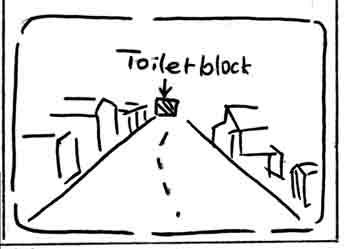
Signs exist which shows this as once being a thriving centre (which it was before the main street shifted across the river).
This can be seen in the remnants of former land use. The NZ Loan & Mercantile Co. Ltd sign above the taxi stand (photo 3); the Oslers bakery sign above the dairy (photo 4); (the new, larger Oslers is visible in photo 9) both of which were central function businesses. Now it remains as only a secondary centre. This further encourages the street to toke on aspects of a declining rural town.
In photo 5, we see many aspects typical of rural, run-down New Zealand towns. Tarmac, mass rusting corrugated iron, wooden power poles, paint a cliched picture of rural NZ.
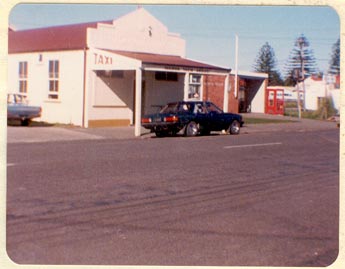 3.
3.
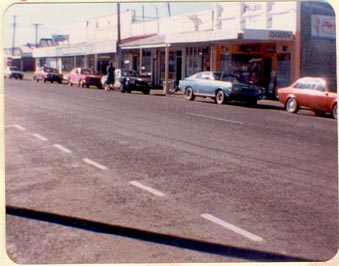 4.
4.
 5.
5.
ENTRY
Entrance to the town is most dramatic from the east. Here, as you rise over Te Uhi Hill, one at first views blank space (diagram to go here). Due to the inclined angle of entry, it seems to be infinite space, rather than just sky.
Then as the hill is traversed, the landscape is suddenly spread out before you. The town is suddenly there.
This is best witnessed at night, when you suddenly come out of the darkness, into the light.
LANDMARK
As one arrives in the town, the landmark of Wairoa - its lighthouse - immediately hits the eye. Photo 7 does not do it justice. Figure b. shows how its effect works. At night it is even better, when it serves as a beacon to the centre of the town.
Choice of location of this feature must be applauded. Although it is situated to the left of the bridge, it has managed to be located so as to be obvious from the entry view down Bridge Street. Obviously some thought was given in decision of this location.
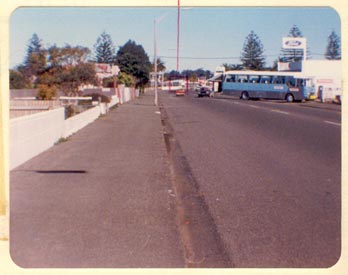 7.
7.
 8.
8.
The photos above and below provide a highly differing view. One is park-like, serene and monumental. The other ordered, urban and central, they seem worlds apart…
 9.
9.
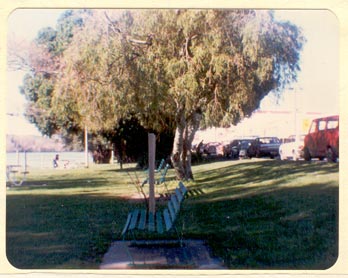 10.
10.
…yet the picture above shows them to be one and the same. This shows one very unique aspect of the town, and its main street (Marine Parade). It is very much a riverside townscape. The commercial, business, civic and leisure activities are all strung out along the river (see Photo 1). No other New Zealand town shares this unique element. Most others are canyon streets, bounded on both side by commercial buildings. Parks are only interspersed as separate spaces. Here, the park and the river are both as important as the main street and the buildings.
Escape is easy from the hustle and bustle of the town. Everywhere just a short walk across the street takes you into a whole new environment. Note the orientation of the chairs in photo 8. They turn their back on the street, and face out to the river. It provides a distinct shift between commercial and park areas in a very small space.
Natural and man-made barriers have helped provide this. The road, the river, and the trees, all serve as physical and visual barriers between the two.
WALKING DOWN THE STREET
Another townscape element is the Marine Parade possesses a distinct start and finish. The above was the start. The bridge (visible in photo 14) and lighthouse serve as the starting point.
Now let’s take a journey down the street, and view its townscape.
POWER POLES
Power poles mar the landscape. And they give an added sense of perspective to the view. Impact of these is arguable. They cannot be seen from under the verandahs. Where they can be seen, across the street, the view is distracted by the river and park. Also, it is worth noting that attempt is being taken to replace these with the sleeker, wireless poles visible in photo 8.
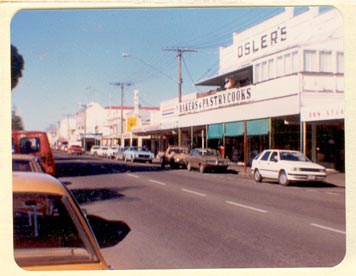 11.
11.
SIDE VIEWS
The two views opposite give side views down alleyways. Here are two enclosed vistas. Photo 12, as well as being a landmark (the church) type view, provides some sense of mystery, in that part of the building is in fact hidden from view. The observer wonders what could be there.
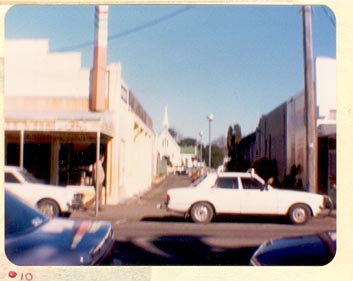 12.
12.
Photo 13’s view is much more enclosed. It has an added element of danger in its darkness.
Architecture on the two buildings is worthy of mention. Both have unique characteristics. The 1913 building in fact has aspects of "Art Deco".
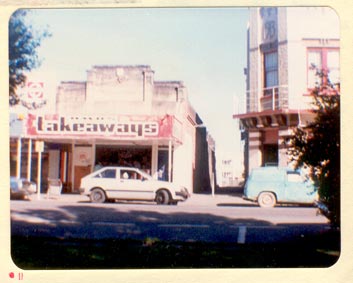 13.
13.
A very "crass" image of townscape. Grey flooring, darkened shops, and ugly commercial frontages.
 14.
14.
Another side view, more power lines. Note the slight river terrace (also visible in photo 13). This places the town front a level below the rest.
 15.
15.
CIVIC CENTRE
Since the definitive start, the townscape has been a jumble of buildings, alleyways, and side-views. Now definition and existence of planning returns. We arrive at what is unofficially the civic centre of Wairoa. Church, library, gardens, return us to a monumental serenity reminescent of the start. It gives a townscape totally distinctive from the other two. It also provides an end to the town, in that it returns us somewhat to where we started. There seems to be little more left to see. The town has been viewed in its entirety.
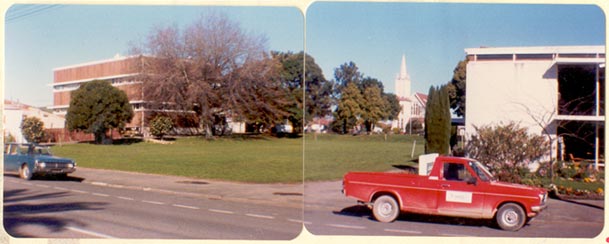
PHOTO 16.
Remnants from an era when businesses were willing to invest in New Zealand’s small towns, these buildings are testimony to Wairoa’s glorious past.
Attention to detail, as with the lion heads to the left, or above the door below or on the ANZ building, or the monumental columns above, reflect this.
These buildings are colourful, both literally, and in design and detail. They possess character fast disappearing from our cities.
 17.
17.
 18.
18.
 19.
19.
Wairoa is a small town of 5000 people. Its only major industry is a freezing works, and it also serves as a service centre for the farming hinterland. These elements are all characteristic of an archetypal small New Zealand town. But, unlike North Clyde, Wairoa’s townscape is not typical of a small town in rural New Zealand.
It has been gifted naturally, and clever planing gives it two points which tie up the main street. Marine Parade is well endowed in these aspects.
One problem, though, can be seen below. Although the main street delineates river from town, giving aspects shown earlier, it also tends to isolate it, which is not good. The riverfront park seems to be an island. Cluse of the main street and development of a mall would help emphasise its riverside townscape.
 20.
20.
Picture 20 is a view from the east end of Marine Parade. Note the bridge and the contrast between river and town. The trees stand up as a barrier between the two, also becoming an island in between river and road.
Also note the strong stepped elements of the three larger buildings on the mian street. It tends to a somewhat repetitive element.